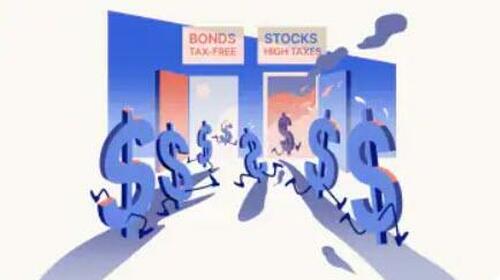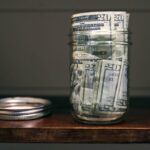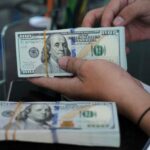
The smooth road the world has travelled on since the Great Financial Crisis, with stable geopolitics, low inflation and low interest rates, was disrupted during the pandemic years, with policymakers and investors betting on a return to the 'old normal'.
In 2024, Saxo warns that it will become clear that the smooth road is at an end, sending the world into a dangerously uncertain future.
Saxo CIO Steen Jakobsen sees the world at an inflection point and their 2024 Outrageous Predictions look at how the world navigates the ultimate end of the ‘old normal’, and how new technologies solve old problems, while creating new, maybe more dangerous dilemmas.
1. With oil at $150, Saudis buy Champions League franchise
As oil prices soar, Saudi Arabia extends its influence by acquiring one of the most coveted franchises in sports to create a World Champions League:
“Saudi Arabia’s radical restructuring of its economy away from its dependency on oil revenues towards becoming a tourism, leisure, and entertainment powerhouse, receives an added boost from a meteoric rise in oil prices, which reach $150 per barrel around mid-year on stronger-than-expected demand. Now holding the keys to the cherished football competition, the Saudis immediately move to transform it into a global club competition.”
The Manchester United stock price doubles and Brent crude goes to $150 per barrel.
2. World hit by major health crisis as obesity drugs make people stop exercising
GLP-1 obesity drugs are seen as a solution to the world’s obesity epidemic, but the ease of taking a pill makes people stop exercising and increase their intake of junk food:
“As supply of GLP-1 obesity drugs is expanded, prices come down and governments choose to designate the obesity drugs as vital for improving health and stopping the obesity epidemic...However, in a turn of events, supply of GLP-1 obesity drugs is unable to meet the widespread demand, and patients need to wait for years to get their injections. Meanwhile, they stop exercising or keeping to a healthy diet now that a pill can keep weight in check, fuelling a major health crisis. Global adult obesity rates shoot up from the current 39% to 45% in 2024."
The processed food industry sees a significant demand lift, McDonalds and Coca-Cola stock prices outperform broader markets by 60% each.
3. US heralds the end of capitalism with tax-free government bonds
The US adopts a radical fiscal strategy to tackle its economic challenges by incentivizing investment in government bonds.
“The US government is forced to increase fiscal spending exponentially amid the 2024 elections to keep the economy going and avoid social unrest. Due to lingering inflation pressures and foreign investors repatriating capital, demand for US Treasuries remains sluggish, provoking a spike in US Treasury yields. In a desperate attempt to normalise borrowing costs, the US government makes income from government bonds tax-free.”
US Treasuries rally across all tenors, and the yield curve bull-flattens as investors can lock in the highest yields in decades without tax burdens. The stock market tumbles, but a selected group of cash-rich companies benefit from an inverted yield curve.
4. Generative AI deepfake triggers a national security crisis
Generative AI, hailed as a productivity boon, becomes a national security threat after a daring AI deepfake heist against a high-ranking official in a developed country. Governments crack down on AI with new regulations, puncturing the AI hype as VCs flee the industry:
“In a high-stakes game, a criminal group deploys the most deceptive generative AI deepfake the world has ever seen, phishing a high-ranking government official to hand over top-secret state information from a developed country. The daring move and success trigger the biggest national security crisis since WWII, ushering in a new era of far-reaching AI regulation. In a historic move to deal with the catastrophic side effects of generative AI, the US and EU declare that all content produced by a generative AI should have the label ‘Made by AI’. The generative AI deepfake incident goes from national security crisis to full-blown public distrust in information delivered on the Internet, as AI-produced content swells to 90% of all information."
Traditional media companies approved by their governments for disseminating public news soar in value, with shares in The New York Times Company doubling. Adobe shares plunge as government penalises the company, as the catastrophic deepfake was made using its software.
5. Deficit countries form ‘Rome Club’ to negotiate trade terms
A coalition of deficit countries aims to restructure global trade dynamics in their favor:
“As the US debt situation has become uncontrollable, a group of six deficit countries form a ‘Rome Club’ to cooperate on reducing deficits by collectively negotiating new world trade terms with the surplus countries. The argument goes that resetting the deficits through gradual pegged revaluations of the surplus countries would enable a global reset, creating a more equal and stable economic model. The six founding countries of the ‘Rome Club’ are the US, UK, India, Brazil, Canada and France. Adjusting the divergence of the current account between the key countries is going to be a painful adjustment for the highest surplus countries which are China, Germany, Norway, Japan, the Netherlands and Singapore.”
The fact that the world’s reserve currency is spinning out of control reduces faith in the fiat money system, setting up big gains for gold, silver, and crypto currencies.
6. Robert F. Kennedy Jr wins the 2024 US presidential election
In a stunning political upset, RFK Jr. captures the presidency, ushering in a new political direction for the United States:
“In 2024, for the first time in the history of the USA, a third-party candidate, Robert F. Kennedy Jr, wins the US presidential election. His populist platform against the war-mongering Democrats and against the corporate elites resonates with both disgruntled traditional Democratic and Trump supporters. A new political era in the USA begins with the dramatic pivot away from plutocracy, as voters demand an end to drastic inequality and injustice and the end of forever wars.”
Kennedy’s pro-peace message and promise to end the abuses of the US healthcare system and break up excess corporate power sees defense, drug and healthcare companies nosedive, and the internet and info-tech monopolies trade nervously on concerns that a wider war against monopoly companies will follow.
7. Japan’s ‘lucky 7%’ GDP growth rate forces BoJ to abandon yield curve control
Japan experiences a surprising economic surge, leading to a significant policy shift by the Bank of Japan.
“The deflation era in Japan has ended, bringing wage growth back. With a yield curve control policy in place, the Japanese economy is over-stimulated as real rates decline with nominal yields capped but inflation expectations rising. The BoJ is therefore forced to end its yield curve control policy in 2024. This causes a rout in global bond markets, as Japanese investors move money back home.”
Yen strengthens as Japanese investors repatriate money to domestic assets, pushing USDJPY below 130, EURJPY below 140 and AUDJPY below 88.
8. Luxury plunges as EU goes Robin Hood, introducing wealth tax
The European Union's new wealth tax leads to a downturn in the luxury market, with major repercussions for high-end brands:
“It is a great irony that the EU, which is the world’s biggest welfare system, has created 499 USD billionaires who are paying the lowest amount of personal tax in percentage of wealth compared to billionaires from North America and East Asia.
As social unrest in Europe is constantly at the edge of eruption, and as costs associated with the green transformation, the war in Ukraine and general inflation rise, the EU Commission commits to the July 2023 European Citizens’ Initiative (ECI) entitled ‘Taxing great wealth to finance the ecological and social transition’.
The EU Commission implements a law that annually taxes 2% of wealth on billionaires. This modern version of Robin Hood sends shockwaves through the European luxury industry, as recent studies have shown a strong correlation between the pursuit of luxury items and levels of income and wealth inequality.”LVMH shares plunge 40% on the EU Commission's new wealth tax and other parts of the luxury segment including Porsche and Ferrari see their share price suffering badly.
Though these predictions are not Saxo Bank's official market forecasts, they are a reminder to investors to consider all potential outcomes, including those that seem far-fetched.
Outrageous Predictions are a deliberate effort to push the boundaries of market participants' imaginations and prepare them for any eventuality.
Finally, while these predictions may seem 'outrageous', some have been much closer to the truth than anticipated:
2023 honourable mention: A country agrees to ban all meat production by 2030
Reviewing last year's predictions, it's evident that they were more outrageous than they were correct. A fan favourite was Market Strategist Charu Chanana's prediction about a country agreeing to ban all meat production by 2030. It didn't turn out that way and it would be a stretch to say that it was close. But, at a supranational level, meat, as an important part of fighting climate change, was spotted on the agenda at the UN-arranged climate change-focused COP28 in the latter part of the year. Here, the UN was, in time of writing, expected to publish a road map for global food systems with a focus on lowering meat consumption.
"While we didn't see any country banning meat production, we did see a growing recognition that meat (and the consumption of it) needs to be in focus when talking about climate change. So, picking a topic that turns out to get attention and taking it a step further than reality is really what this exercise is about," says Chanana.
2022 Outrageous Prediction: The plan to end fossil fuels gets a rain check
As we headed into 2022, Ole S. Hansen, Head of Commodity Strategy, wrote that policymakers would kick climate targets down the road and support fossil fuel investment to fight inflation and the risk of social unrest, while rethinking the path to a low-carbon future.
The overarching prediction came to fruition, but it was regrettably fueled by the unforeseen invasion of Ukraine by Russia.
"Little did we know last November that the world was galloping into an energy crisis triggered by Russia’s war in Ukraine," says Ole S. Hansen, Head of Commodity Strategy, who explains how he then caught on to the idea that fossil fuels would become relevant again in 2022: "Lack of investments and an increasingly urgent need to support gas over coal led us to come up with this idea, which basically envisaged a more investor friendly environment for (up until then) shamed investment in so-called 'dirty' energy production. A move that led to the decision by the EU to classify gas and nuclear as green investments," he says.
2018 Outrageous Prediction: Volatility spikes after flash crash in stock markets
"We did not get a 25% drop in a single 1987-like event, but we did get two dramatic events in 2018 that vindicated our point," says Peter Garnry, Head of SaxoStrats.
He further explains how the prediction came about: "We got the idea about this Outrageous Prediction in late 2017, as the year was about to end with astonishingly low volatility and Bitcoin had gone from just below $1,000 in late 2016 to around USD 10,000 in November 2017 (Bitcoin eventually rose to almost USD 20,000 before year end). Everyone speculated in Bitcoin and selling volatility in currencies and equities was heralded as easy predictable money. That's where we got this super awkward feeling that the entire euphoria and these types of positions can have dramatic outcomes if conditions change even the slightest."
Garnry says that the volatility kicked in during February and ended in dramatic fashion over Christmas: "The ‘Volmageddon’ event in February 2018 almost completely wiped out short volatility funds including some famous ETFs in these strategies as the VIX Index exploded from 13.64 to 50.30 in just two trading sessions. The event changed the short volatility complex in the subsequent years. Later in 2018, the market was trying to tell the Fed that it was doing a policy mistake by hiking its policy rates because the economy was deteriorating. It led to a selloff of 20% from the peak in October to the intraday bottom on 26 December 2018 with the most dramatic trading sessions happening over the Christmas holiday period when liquidity was drying up. Dramatic events that set the stage for the crazy bull-run in 2019 as investors again forgot everything about risk."
2017 Outrageous Prediction: Huge gains for Bitcoin as the cryptocurrencies rise
As cryptocurrencies, particularly Bitcoin, began gathering momentum in the public eye, our SaxoStrats predicted that the then leading currency would have a huge bump in value. The rationale behind the jump was justified by US President Donald Trump's regime overspending, causing national debt to rise and inflation to skyrocket. Combining this with the global public wanting to break away from the currencies of central banks, Bitcoin became a preferred alternative. The Outrageous Prediction ended up coming to fruition and more, with the price of Bitcoin growing to almost USD 20,000 at its 2017 peak.
However, the circumstances around the prediction weren’t spot on. It wasn’t as much due to macroeconomic movements of the Trump era, as it was due to speculation in Bitcoin that fueled its initial meteoric rise. However, when looking at the more recent spikes in cryptocurrencies, particularly Bitcoin in 2021, the justifications outlined in the 2017 Outrageous Prediction held true.
2015 Outrageous Prediction: Brexit in 2017
In the Outrageous Predictions for 2015, our SaxoStrats wrote that the UK Independence Party (UKIP) would win 25% of the national vote in Britain’s general election on 7 May, 2015, sensationally becoming the third largest party in parliament. UKIP would then join David Cameron’s Conservatives in a coalition government and call for the planned referendum on Britain’s membership of the EU in 2017. As a result, UK government debt suffers a sharp rise in yields.
The timing was a bit off, but the circumstances around it were pretty accurate. “We had a very strong sense that ‘protest votes’ would be coming both in the US election and also ultimately in a vote on Brexit” said Steen Jakobsen, CIO at Saxo. “We, to some extent, correctly talked about the ‘social-contract being broken’ – meaning society no longer benefitted as a whole from monetary policy, which created an increased gap in equality.
“This call was too early, but the context and reasoning was spot on. The split in the Tory Party could not be healed and the modus operandi of ‘Talking down to the voters’ was a blatant mistake, which we used for this call,” Jakobsen said.
2013 Outrageous Prediction: Gold corrects to USD 1,200 per ounce
"Our $1,200 call, at the time of writing, signaled a one-third drop in the price," says Head of Commodity Strategy, Ole S. Hansen who, in 2013, had the first correct Outrageous Prediction.
Here's what he had to say about it: "Gold corrected to and actually went below USD 1,200 per ounce in 2013, as investors increasingly turned their attention to stocks and the dollar. A major trigger was the April 2013 break below key support at $1,525 - a move that in our mind raised the risk of a bear market taking the price down towards $1,100," says Hansen.
So how many of this year's "predictions" will come true next year?
The smooth road the world has travelled on since the Great Financial Crisis, with stable geopolitics, low inflation and low interest rates, was disrupted during the pandemic years, with policymakers and investors betting on a return to the ‘old normal’.
In 2024, Saxo warns that it will become clear that the smooth road is at an end, sending the world into a dangerously uncertain future.
Saxo CIO Steen Jakobsen sees the world at an inflection point and their 2024 Outrageous Predictions look at how the world navigates the ultimate end of the ‘old normal’, and how new technologies solve old problems, while creating new, maybe more dangerous dilemmas.
1. With oil at $150, Saudis buy Champions League franchise
As oil prices soar, Saudi Arabia extends its influence by acquiring one of the most coveted franchises in sports to create a World Champions League:
“Saudi Arabia’s radical restructuring of its economy away from its dependency on oil revenues towards becoming a tourism, leisure, and entertainment powerhouse, receives an added boost from a meteoric rise in oil prices, which reach $150 per barrel around mid-year on stronger-than-expected demand. Now holding the keys to the cherished football competition, the Saudis immediately move to transform it into a global club competition.”
The Manchester United stock price doubles and Brent crude goes to $150 per barrel.
2. World hit by major health crisis as obesity drugs make people stop exercising
GLP-1 obesity drugs are seen as a solution to the world’s obesity epidemic, but the ease of taking a pill makes people stop exercising and increase their intake of junk food:
“As supply of GLP-1 obesity drugs is expanded, prices come down and governments choose to designate the obesity drugs as vital for improving health and stopping the obesity epidemic…However, in a turn of events, supply of GLP-1 obesity drugs is unable to meet the widespread demand, and patients need to wait for years to get their injections. Meanwhile, they stop exercising or keeping to a healthy diet now that a pill can keep weight in check, fuelling a major health crisis. Global adult obesity rates shoot up from the current 39% to 45% in 2024.”
The processed food industry sees a significant demand lift, McDonalds and Coca-Cola stock prices outperform broader markets by 60% each.
3. US heralds the end of capitalism with tax-free government bonds
The US adopts a radical fiscal strategy to tackle its economic challenges by incentivizing investment in government bonds.
“The US government is forced to increase fiscal spending exponentially amid the 2024 elections to keep the economy going and avoid social unrest. Due to lingering inflation pressures and foreign investors repatriating capital, demand for US Treasuries remains sluggish, provoking a spike in US Treasury yields. In a desperate attempt to normalise borrowing costs, the US government makes income from government bonds tax-free.”
US Treasuries rally across all tenors, and the yield curve bull-flattens as investors can lock in the highest yields in decades without tax burdens. The stock market tumbles, but a selected group of cash-rich companies benefit from an inverted yield curve.
4. Generative AI deepfake triggers a national security crisis
Generative AI, hailed as a productivity boon, becomes a national security threat after a daring AI deepfake heist against a high-ranking official in a developed country. Governments crack down on AI with new regulations, puncturing the AI hype as VCs flee the industry:
“In a high-stakes game, a criminal group deploys the most deceptive generative AI deepfake the world has ever seen, phishing a high-ranking government official to hand over top-secret state information from a developed country. The daring move and success trigger the biggest national security crisis since WWII, ushering in a new era of far-reaching AI regulation. In a historic move to deal with the catastrophic side effects of generative AI, the US and EU declare that all content produced by a generative AI should have the label ‘Made by AI’. The generative AI deepfake incident goes from national security crisis to full-blown public distrust in information delivered on the Internet, as AI-produced content swells to 90% of all information.”
Traditional media companies approved by their governments for disseminating public news soar in value, with shares in The New York Times Company doubling. Adobe shares plunge as government penalises the company, as the catastrophic deepfake was made using its software.
5. Deficit countries form ‘Rome Club’ to negotiate trade terms
A coalition of deficit countries aims to restructure global trade dynamics in their favor:
“As the US debt situation has become uncontrollable, a group of six deficit countries form a ‘Rome Club’ to cooperate on reducing deficits by collectively negotiating new world trade terms with the surplus countries. The argument goes that resetting the deficits through gradual pegged revaluations of the surplus countries would enable a global reset, creating a more equal and stable economic model. The six founding countries of the ‘Rome Club’ are the US, UK, India, Brazil, Canada and France. Adjusting the divergence of the current account between the key countries is going to be a painful adjustment for the highest surplus countries which are China, Germany, Norway, Japan, the Netherlands and Singapore.”
The fact that the world’s reserve currency is spinning out of control reduces faith in the fiat money system, setting up big gains for gold, silver, and crypto currencies.
6. Robert F. Kennedy Jr wins the 2024 US presidential election
In a stunning political upset, RFK Jr. captures the presidency, ushering in a new political direction for the United States:
“In 2024, for the first time in the history of the USA, a third-party candidate, Robert F. Kennedy Jr, wins the US presidential election. His populist platform against the war-mongering Democrats and against the corporate elites resonates with both disgruntled traditional Democratic and Trump supporters. A new political era in the USA begins with the dramatic pivot away from plutocracy, as voters demand an end to drastic inequality and injustice and the end of forever wars.”
Kennedy’s pro-peace message and promise to end the abuses of the US healthcare system and break up excess corporate power sees defense, drug and healthcare companies nosedive, and the internet and info-tech monopolies trade nervously on concerns that a wider war against monopoly companies will follow.
7. Japan’s ‘lucky 7%’ GDP growth rate forces BoJ to abandon yield curve control
Japan experiences a surprising economic surge, leading to a significant policy shift by the Bank of Japan.
“The deflation era in Japan has ended, bringing wage growth back. With a yield curve control policy in place, the Japanese economy is over-stimulated as real rates decline with nominal yields capped but inflation expectations rising. The BoJ is therefore forced to end its yield curve control policy in 2024. This causes a rout in global bond markets, as Japanese investors move money back home.”
Yen strengthens as Japanese investors repatriate money to domestic assets, pushing USDJPY below 130, EURJPY below 140 and AUDJPY below 88.
8. Luxury plunges as EU goes Robin Hood, introducing wealth tax
The European Union’s new wealth tax leads to a downturn in the luxury market, with major repercussions for high-end brands:
“It is a great irony that the EU, which is the world’s biggest welfare system, has created 499 USD billionaires who are paying the lowest amount of personal tax in percentage of wealth compared to billionaires from North America and East Asia.
As social unrest in Europe is constantly at the edge of eruption, and as costs associated with the green transformation, the war in Ukraine and general inflation rise, the EU Commission commits to the July 2023 European Citizens’ Initiative (ECI) entitled ‘Taxing great wealth to finance the ecological and social transition’.
The EU Commission implements a law that annually taxes 2% of wealth on billionaires. This modern version of Robin Hood sends shockwaves through the European luxury industry, as recent studies have shown a strong correlation between the pursuit of luxury items and levels of income and wealth inequality.”
LVMH shares plunge 40% on the EU Commission’s new wealth tax and other parts of the luxury segment including Porsche and Ferrari see their share price suffering badly.
Though these predictions are not Saxo Bank’s official market forecasts, they are a reminder to investors to consider all potential outcomes, including those that seem far-fetched.
Outrageous Predictions are a deliberate effort to push the boundaries of market participants’ imaginations and prepare them for any eventuality.
Finally, while these predictions may seem ‘outrageous’, some have been much closer to the truth than anticipated:
2023 honourable mention: A country agrees to ban all meat production by 2030
Reviewing last year’s predictions, it’s evident that they were more outrageous than they were correct. A fan favourite was Market Strategist Charu Chanana’s prediction about a country agreeing to ban all meat production by 2030. It didn’t turn out that way and it would be a stretch to say that it was close. But, at a supranational level, meat, as an important part of fighting climate change, was spotted on the agenda at the UN-arranged climate change-focused COP28 in the latter part of the year. Here, the UN was, in time of writing, expected to publish a road map for global food systems with a focus on lowering meat consumption.
“While we didn’t see any country banning meat production, we did see a growing recognition that meat (and the consumption of it) needs to be in focus when talking about climate change. So, picking a topic that turns out to get attention and taking it a step further than reality is really what this exercise is about,” says Chanana.
2022 Outrageous Prediction: The plan to end fossil fuels gets a rain check
As we headed into 2022, Ole S. Hansen, Head of Commodity Strategy, wrote that policymakers would kick climate targets down the road and support fossil fuel investment to fight inflation and the risk of social unrest, while rethinking the path to a low-carbon future.
The overarching prediction came to fruition, but it was regrettably fueled by the unforeseen invasion of Ukraine by Russia.
“Little did we know last November that the world was galloping into an energy crisis triggered by Russia’s war in Ukraine,” says Ole S. Hansen, Head of Commodity Strategy, who explains how he then caught on to the idea that fossil fuels would become relevant again in 2022: “Lack of investments and an increasingly urgent need to support gas over coal led us to come up with this idea, which basically envisaged a more investor friendly environment for (up until then) shamed investment in so-called ‘dirty’ energy production. A move that led to the decision by the EU to classify gas and nuclear as green investments,” he says.
2018 Outrageous Prediction: Volatility spikes after flash crash in stock markets
“We did not get a 25% drop in a single 1987-like event, but we did get two dramatic events in 2018 that vindicated our point,” says Peter Garnry, Head of SaxoStrats.
He further explains how the prediction came about: “We got the idea about this Outrageous Prediction in late 2017, as the year was about to end with astonishingly low volatility and Bitcoin had gone from just below $1,000 in late 2016 to around USD 10,000 in November 2017 (Bitcoin eventually rose to almost USD 20,000 before year end). Everyone speculated in Bitcoin and selling volatility in currencies and equities was heralded as easy predictable money. That’s where we got this super awkward feeling that the entire euphoria and these types of positions can have dramatic outcomes if conditions change even the slightest.”
Garnry says that the volatility kicked in during February and ended in dramatic fashion over Christmas: “The ‘Volmageddon’ event in February 2018 almost completely wiped out short volatility funds including some famous ETFs in these strategies as the VIX Index exploded from 13.64 to 50.30 in just two trading sessions. The event changed the short volatility complex in the subsequent years. Later in 2018, the market was trying to tell the Fed that it was doing a policy mistake by hiking its policy rates because the economy was deteriorating. It led to a selloff of 20% from the peak in October to the intraday bottom on 26 December 2018 with the most dramatic trading sessions happening over the Christmas holiday period when liquidity was drying up. Dramatic events that set the stage for the crazy bull-run in 2019 as investors again forgot everything about risk.”
2017 Outrageous Prediction: Huge gains for Bitcoin as the cryptocurrencies rise
As cryptocurrencies, particularly Bitcoin, began gathering momentum in the public eye, our SaxoStrats predicted that the then leading currency would have a huge bump in value. The rationale behind the jump was justified by US President Donald Trump’s regime overspending, causing national debt to rise and inflation to skyrocket. Combining this with the global public wanting to break away from the currencies of central banks, Bitcoin became a preferred alternative. The Outrageous Prediction ended up coming to fruition and more, with the price of Bitcoin growing to almost USD 20,000 at its 2017 peak.
However, the circumstances around the prediction weren’t spot on. It wasn’t as much due to macroeconomic movements of the Trump era, as it was due to speculation in Bitcoin that fueled its initial meteoric rise. However, when looking at the more recent spikes in cryptocurrencies, particularly Bitcoin in 2021, the justifications outlined in the 2017 Outrageous Prediction held true.
2015 Outrageous Prediction: Brexit in 2017
In the Outrageous Predictions for 2015, our SaxoStrats wrote that the UK Independence Party (UKIP) would win 25% of the national vote in Britain’s general election on 7 May, 2015, sensationally becoming the third largest party in parliament. UKIP would then join David Cameron’s Conservatives in a coalition government and call for the planned referendum on Britain’s membership of the EU in 2017. As a result, UK government debt suffers a sharp rise in yields.
The timing was a bit off, but the circumstances around it were pretty accurate. “We had a very strong sense that ‘protest votes’ would be coming both in the US election and also ultimately in a vote on Brexit” said Steen Jakobsen, CIO at Saxo. “We, to some extent, correctly talked about the ‘social-contract being broken’ – meaning society no longer benefitted as a whole from monetary policy, which created an increased gap in equality.
“This call was too early, but the context and reasoning was spot on. The split in the Tory Party could not be healed and the modus operandi of ‘Talking down to the voters’ was a blatant mistake, which we used for this call,” Jakobsen said.
2013 Outrageous Prediction: Gold corrects to USD 1,200 per ounce
“Our $1,200 call, at the time of writing, signaled a one-third drop in the price,” says Head of Commodity Strategy, Ole S. Hansen who, in 2013, had the first correct Outrageous Prediction.
Here’s what he had to say about it: “Gold corrected to and actually went below USD 1,200 per ounce in 2013, as investors increasingly turned their attention to stocks and the dollar. A major trigger was the April 2013 break below key support at $1,525 – a move that in our mind raised the risk of a bear market taking the price down towards $1,100,” says Hansen.
So how many of this year’s “predictions” will come true next year?
Loading…














